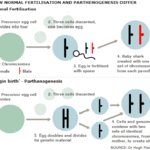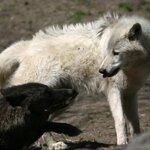Genetics & Molecular Biology

A system of opposing genetic forces determines why mammals develop a single row of teeth, while sharks sport several, according to a study published today in the journal Science. When completely understood, the genetic program described in the study may help guide efforts to re-grow missing teeth and prevent cleft palate, one of the most common birth defects.
Gene expression is the process by which information stored in genes is converted into proteins that make up the body's structures and carry its messages. As the baby's face takes shape in the womb, the development of teeth and palate are…

There was a study done over a decade ago by Claud Wedekind in which 44 men wore the same T-shirt for three days, refraining from deodorants and scented soaps so they wouldn’t interfere with their smell. Thereafter women sniffed the shirts and indicated which ones they felt smelled the best. In this test, the researchers found that women preferred the smell of a man whose MHC (major histocompatibility complex), which is a series of genes involved in our immune system, was most different from their own.
But there was an exception... The MHC attraction for women taking the…

A major mystery about the origins of life may be resolved if a new hypothesis holds up, says a study published in Nature. Two Université de Montréal scientists have proposed a new idea for how a 'universal molecular machine', the ribosome, might have managed to self-assemble as a critical step in the genesis of all life on Earth.
The ribosome is an enormous molecule responsible for translating the messages carried in the genetic code of all organisms into the workhorse molecules of the cell – proteins – that carry out all functions, including replicating the genome itself. As the…

Plants are obviously essential to our survival and that of most other animals on earth but it is easy to overlook how they have become discretely embedded into our everyday lives; plants provide us with food, medicines, and raw materials used by our industries.
Despite their importance, very few of us could name more than a tiny fraction of the plants that surround us and while most of us could easily between a buttercup and a dandelion (provided both are in flower), only a hand full of experts could identify all 1600 native plants in the UK - and nobody is able to name all of the 250,000 or…

Research performed in the Center for Biomolecular Science&Engineering (CBSE) at the University of California, Santa Cruz, suggests that mobile repetitive elements--also known as transposons or "jumping genes"--do indeed affect the evolution of gene regulatory networks.
David Haussler, CBSE director and distinguished professor of biomolecular engineering at UCSC's Jack Baskin School of Engineering, said CBSE research teams are finding evidence that the early theories of Nobel Prize winner Barbara McClintock, later modeled by Roy Britten and Eric Davidson, are correct. Haussler will discuss…

I am a firm believer in the possibility and promise of embryonic stem cells. In a politically, religiously and even scientifically charged climate, this is a risky thing to announce. But as a journalist, I must divorce myself from my own personal opinions and biases and present the facts. That being said, it is still satisfying writing upon a topic that you believe in. This was the case when I wrote an article about Geron Pharmaceuticals recently launched human clinical trials using embryonic stem cell research to repair spinal cord damage.
Shortly after publishing this article, I was…

Neandertals were the closest relatives of currently living humans. They lived in Europe and parts of Asia until they became extinct about 30,000 years ago. For more than a hundred years, paleontologists and anthropologists have been striving to uncover their evolutionary relationship to modern humans.
The Max Planck Institute for Evolutionary Anthropology, in Leipzig, Germany, and the 454 Life Sciences Corporation, in Branford, Connecticut, announced that they have completed a first draft version of the Neandertal genome. The project is directed by Prof. Svante Pääbo, Director of the…

Man, I love it when scientists discover and publish things on a schedule that matches my state-mandated curriculum! It really makes my job a lot easier. (Also, the joke in the title line is a super-lame joke that my students tend to make when we get to the unit...they think they are quite the comedians.)
OK, so maybe that's not entirely true, but...this article was so timely, it made me very happy (also, bonus- pretty fluorescent cell pictures!). In my Biology classes, we have been studying mitosis, aka cell division. It's sometimes difficult, but also interesting, to…

A common gene regulatory circuit controls the development of all dentitions, from the first teeth in the throats of jawless fishes that lived half a billion years ago to the incisors and molars of modern vertebrates (that includes you and me), say researchers from Georgia Institute of Technology and the University of Georgia.
The first vertebrates to have teeth were a group of eel-like jawless fish known as the conodonts that had teeth not in their mouth, but lining the throat. This particular group is long since extinct, but some modern fish retain teeth in the throat (pharynx). …

Emergence of black-colored wolves is the direct result of humans raising dogs as pets and beasts of burden, according to new research by a University of Calgary biologist in Science. The dark coloring may also aid the survival of the species as wolf habitat is affected by climate change in the future, the study suggests.
The study by Marco Musiani, professor in the U of C's Faculty of Environmental Design, and colleagues used genetic analysis of gray wolf populations from North America and Europe to trace the source of the dominant gene responsible for dark coat color in wolves back to…